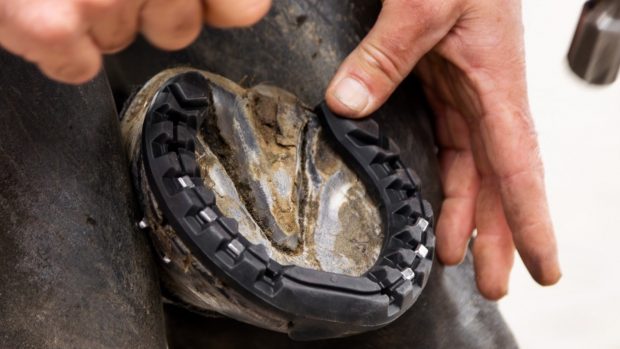Four-point shoeing was developed by farrier Gene Ovnicek and vet Bob Bowker, both from the US, who studied the natural wear of mustangs’ hooves.
They found most of the weight was borne by the sole rather than the wall, with two-thirds of the weight taken at the back (conventional shoeing puts this ratio at about 50/50).
The shoe is fitted to the column of bones rather than the hoof wall. It has a square toe and no toe clips, so the foot is left considerably shorter. The sole and frog are left to bear extra weight, along with the heel.
Imagine cutting off the toe square between traditional toe clips: the first two weight-bearing points are at each end of that line. Then, there are two at opposite points on the heels. The fifth point is the frog.
What do farriers say
Farriers agree that each horse must be treated as an individual case as four-point shoeing doesn’t suit all horses.
“I prefer to call it natural balance shoeing,” says Ian Hughes, remedial farrier at the Ashbrook Equine Hospital and Liverpool University Large Animal Hospital.
“The results are remarkable, with soundness returning far more quickly than before. I have used it on horses who have been off work for a whole season and have then become sound within one or two shoeings.”
Ian believes the system is most suited to remedial shoeing for problems caused by long toes, including laminitis, and can relieve pressure on conditions such as corns.
“If there is pain in the navicular region and X-rays show the bone has changed, navicular disease tends to be diagnosed when the pain may actually be caused by a conventional shoe not supporting the heel sufficiently,” says Ian.
“Quarter-clipped eggbars used to be used to push the weight back but we are now developing a centrally-supportive shoe which is similar to a heartbar, but will not require X-rays to fit as the heartbar does.”
Ian thinks many people are resistant to the idea because it looks so different.
“You have to get the owner’s confidence,” he says. “I think this method will replace eggbars, which get pulled off easily. It may not replace heartbars as they are used in more specific cases. We could, however, combine the two methods – by fitting a heartbar with a square toe, for example.”
While Ian Hughes suggests farriers who remain cynical about four-point shoeing may be those who are resistant to change, many give it a cautious welcome.
“Four-point shoeing has its uses and can be useful in some cases,” says one, who asked notto be named. “I’m not sure how a study done on wild mustangs can truly represent the average ‘domestic’ horse, when you consider all the factors from weight-bearing to ground conditions.”
For more information visit www.bva.co.uk




